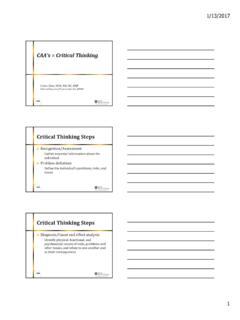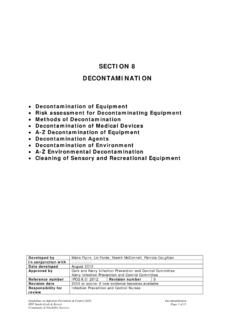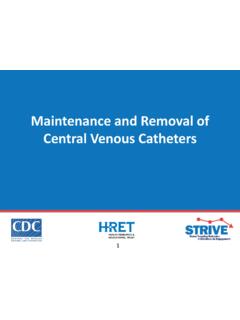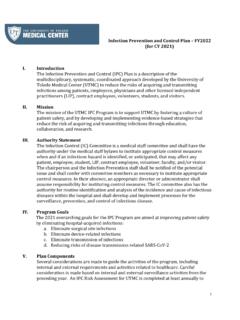Transcription of Facility Self-Assessment (Mock Survey ... - Nursing Home …
1 Facility Self-Assessment ( mock Survey ). Tool SECTION 5 - Facility Self-Assessment ( mock . Survey TOOLS). Facility Self-Assessment - mock surveys are an opportunity to look at systems, procedures and processes of care and to identify potential Survey -risk areas. mock surveys should be performed on a scheduled basis and shared with Nursing home staff. The most important part of the Survey process is what you do after it is over with the results. F-tags are used in this section. Be advised that CMS makes revisions to the F-tags on a regular basis. SECTION PAGE#. Administration 5. Article: mock Survey : An Important Component 6-7. Self-Assessment / mock Survey 8. Guide to F-Tag Numbers 9-10. Long Term Care Survey Process (LTCSP) Procedure Guide 11-61. Survey Scope & Severity Grid 62. Offsite Preparation Worksheet 63. Initial Pool Care Areas Resident Observation 64-76.
2 Limited Record Review 77-80. Resident Representative Interview 81-95. Resident Interview 96-109. Mandatory Facility Task CMS 20053 Dining Observation 110-116. CMS 20054 Infection Prevention, Control, & Immunizations 117-122. CMS 20055 Kitchen Observation 123-129. CMS 20052 Beneficiary Protection Notification Review 130-132. CMS 20056 Medication Administration Observation 133-137. CMS 20089 Medication Storage and Labeling 138. CMS 20058 QAA & QAPI 139-141. CMS 20057 Resident Council Interview 142-145. CMS 20062 Sufficient & Competent Nurse Staffing 146-153. First Impressions Checklist 154. Administration Checklist 155. Contract Book Checklist 156. Personnel File Checklist 157. Critical Element Pathways CMS-20059 Abuse 158-169. CMS-20063 Personal Funds 170-173. CMS-20091 Extended Survey 174-177. CMS-20130 Neglect 178-183.
3 Environment 184. Physical Plant Rounds-Initial Tour 185-205. Fire Drill Grid 206. CMS-20061 Environmental Observations 207-210. Nursing 211. MDS Audit Tool 212-213. Chart Audit Tool 214-215. CMS 20054 Infection Prevention Control 216-221. CMS 20056 Medication Administration Observation 222-226. CMS 20059 Abuse 227-238. CMS 20062 Sufficient & Competent Nurse Staffing 239-246. CMS-20066 Activities of Daily Living 247-253. CMS-20067 Behavioral-Emotional 254-258. CMS-20068 Urinary catheter or UTI 259-263. CMS-20069 Communication-Sensory 264-268. CMS-20071 Dialysis 269-277. CMS-20072 General 278-281. CMS-20073 Hospice and End of Life 282-286. CMS-20074 Death 287-289. CMS-20075 Nutrition 290-295. CMS-20076 Pain Management 296-300. CMS-20077 Physical Restraints 301-306. CMS-20078 Pressure Ulcer 307-311. CMS-20080 Rehab and Restorative 312-315.
4 CMS-20081 Respiratory Care 316-322. CMS-20082 Unnecessary Medications 323-331. CMS-20089 Medication Storage and Labeling 332. CMS-20092 Hydration 333-336. CMS-20093 Tube Feeding 337-343. CMS-20120 Positioning, Mobility, ROM 344-350. CMS-20123 Hospitalization 351-356. CMS-20125 Bladder and Bowel Incontinence 357-361. CMS-20127 Accidents 362-369. CMS-20130 Neglect 370-375. CMS-20131 Resident assessment 376-377. CMS-20132 Discharge 378-381. CMS-20133 Dementia Care 382-385. Matrix with Instructions 386-388. CMS 672 - Resident Census and Conditions of Residents 389-395. Initial Certification Tag Review Tool 396-399. Psychosocial Severity Guide 400-406. Dietary 407. Dietary Observations 408. Monthly Meal Quality Review 409. Monthly Sanitation/Infection Control Review 410. Meal Audit Tool 411. CMS-20053 Dining 412-418. CMS-20055 Kitchen 419-425.
5 CMS-20075 Nutrition 426-431. Social Services 432. LTCSP Resident Interview Care Area 433-446. LTCSP Resident Representative Care Area 447-461. LTCSP Resident Observation Care Area 462-474. Psychosocial Outcome Severity Guide 475-481. CMS 20052 Beneficiary Notice 482-484. CMS 20057 Resident Council 485-488. CMS 20059 Abuse 489-500. CMS 20063 Personal Funds 501-504. CMS 20065 Activities 505-509. CMS 20067 Behavioral-Emotional 510-514. CMS 20069 Communication-Sensory 515-519. CMS 20073 Hospice-End of Life 520-524. CMS 20090 PASARR 525-528. CMS 20130 Neglect 529-534. CMS 20132 Discharge 535-538. CMS 20133 Dementia Care 539-542. Updated June 2018. ADMINISTRATION. 5. mock Survey : An Important Component of Survey Preparation Many long-term care providers strive to be Survey -ready' all year round. But just like many of us schedule the big spring cleaning some time in advance of company arriving for their annual summer visit; some LTC.
6 Providers opt to conduct a mock Survey in anticipation of their annual licensure/certification visit. mock Surveys can serve several purposes: A mock Survey can be an opportunity to take a fresh look at systems, procedures and processes of care, and identify potential Survey -risk areas. And Survey -risk can translate into litigation-risk. A mock Survey also can reveal how staff will function under stressful circumstances. Taking that fresh and objective look is essential in order to reap the maximum benefit from the mock Survey process. LTC providers are discovering the hard way that the procedures, protocols and monitoring/QA systems that served them well enough in the past are no longer sufficient to avoid Survey deficiencies. But we've always done it this way; the surveyors never cited us on this in the past; we thought we were doing this correctly; we've always done well on our surveys before how could this be happening?
7 ' It is hard to stay current with new standards and the more stringent application of existing standards like F314 Pressure Ulcers, F315 Continence/Catheters, F323 Accidents, etc. It is hard to look at one's own organization and see its shortcomings. One way to get a fresh and objective perspective and to minimize Survey -risk is to have the mock Survey process conducted by someone external to your organization. This someone' could be a consultant or an experienced and well informed professional from a neighboring LTC community. If, however, you elect to manage the process using your own personnel, incorporating the following approaches can facilitate objectivity: Assign department heads to Survey ' departments other than their own. In Nursing , have charge nurses/unit managers, supervisors, etc., assigned to audit other units and/or aspects of care for which they are not usually responsible.
8 It is often hard to see your own forest for the trees. Although obviously the internal surveyors' will know that a mock Survey will be taking place at some point, it could be more beneficial if direct care staff and other workers were not informed. This maximizes the surprise and stress factor. Even though the internal surveyors' know that the process is planned, the mock Survey should be unannounced. The Administrator walks in one morning and proclaims it to be mock Survey Day. This simulates real life' The most important part of the mock Survey process is what you do after it's over. If you have about three months between the mock Survey and the earliest likely date of the next Survey , then I recommend the Systems' approach. The Systems approach includes a broader review and analysis of organizational policies, procedures, protocols and practices that may be contributing to Quality Indicator Report flags and/or to the findings' of the mock Survey Survey team.
9 ' If you have one month or less between the mock Survey and the earliest likely date of the next Survey , then I recommend you go into Manage the Damage Mode.' What are your high-risk areas, which residents have experienced negative outcomes, how can the risk be lessened and/or the negative outcome be explained and/or otherwise addressed? In either scenario, Systems or Manage the Damage Mode develop a Corrective Action Roadmap that 6. assigns responsibility, targets timeframes and breaks down the plan into operational steps. Pre- Survey preparation and risk management are the two most effective tools we have to weather today's regulatory climate. Most LTC providers, if they haven't endured it already themselves, know of a provider in their area- good reputation, well respected in their community, satisfactory Survey history that has been blown out of the water during their last Survey .
10 Wouldn't you rather have a friendly outsider' or your own team discovers the dust-bunnies before the surveyors do? Reprint from The Edge, April 29, 2009. The Edge is provided to members of the Kansas Association of Homes and Services for the Aging in partnership with Life Services Network, the Illinois AAHSA affiliate. Authored by Dorrie J. Seyfried, Vice President of Method Management, Risk Management & LTC Consultants based in St. Charles, Illinois. 7. Self-Assessment / mock Survey Today, more than ever, Nursing facilities must be prepared to demonstrate compliance with federal regulations not only at Survey time, but all year long. Survey teams can arrive at facilities as soon as nine months after the last annual Survey . They can appear at any time to conduct complaint investigation surveys. And, these days, they are likely to begin surveys at nontraditional times and on weekends.














